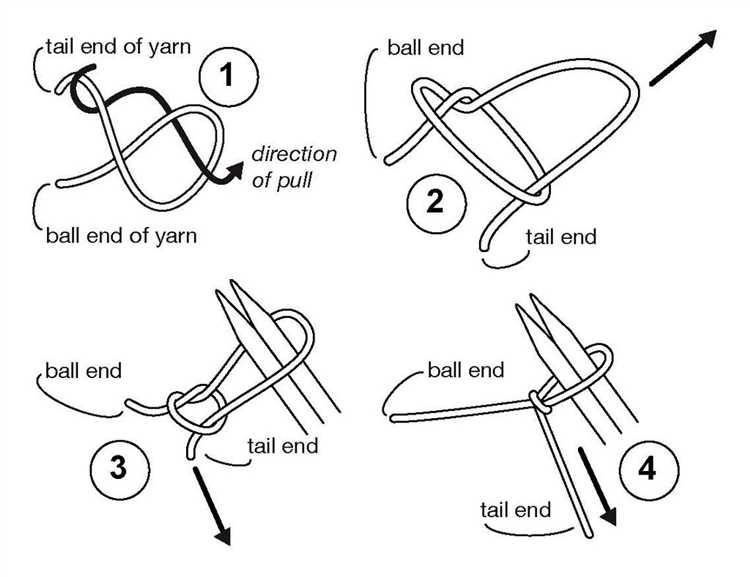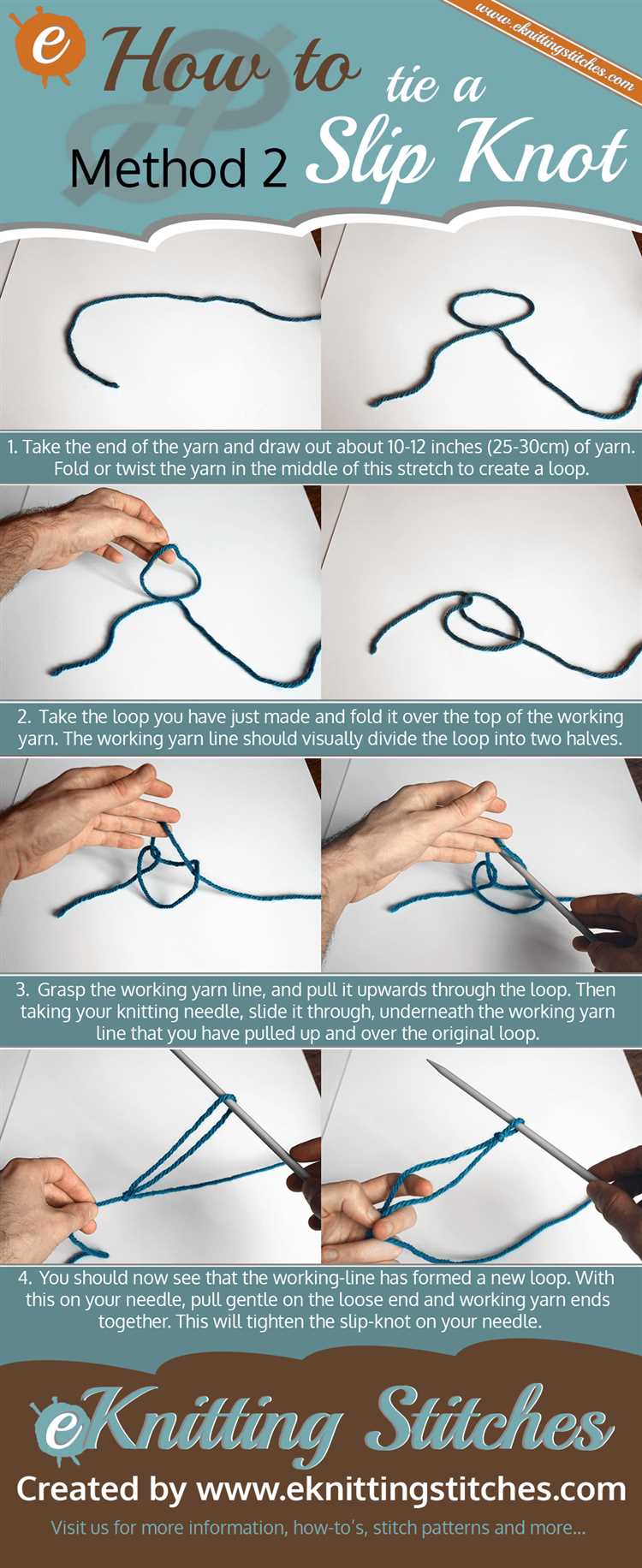Knitting is a wonderful craft that allows you to create beautiful garments and accessories with just a pair of needles and some yarn. One of the most important skills to learn as a knitter is how to make a slip knot. A slip knot is the first step in starting any knitting project, and it is used to secure the yarn to the needle before you begin stitching.
To make a slip knot, you will need a length of yarn and a pair of knitting needles. Start by holding the end of the yarn in your hand, leaving a small tail. Then, with your other hand, make a loop with the yarn, crossing the end over the tail. Bring the end of the yarn through the loop, creating a slip knot. Make sure the loop is loose enough to slide along the tail of the yarn.
Once you have created the slip knot, you can then insert one of the knitting needles through the loop, pulling it tight. This will secure the loop to the needle and create a starting point for your knitting. The slip knot should be snug around the needle, but not too tight that it is difficult to work with.
Remember, practice makes perfect when it comes to making slip knots for knitting. It may take a few tries to get the hang of it, but with patience and persistence, you will soon be able to easily create slip knots and start your knitting projects with confidence.
Now that you have mastered the art of making a slip knot, you are ready to begin your next knitting adventure. Whether you are knitting a cozy scarf, a warm sweater, or a stylish hat, the slip knot is the first step in bringing your creative vision to life. Happy knitting!
Materials Needed
- A ball of yarn
- A pair of knitting needles
- Scissors
Before you begin making a slip knot for knitting, make sure you have the following materials ready:
| Material | Description |
| Yarn | A ball of yarn in the color and thickness of your choice. Make sure it is suitable for knitting. |
| Knitting Needles | A pair of knitting needles that match the recommended size for your yarn. Different knitting projects may require different needle sizes. |
| Scissors | A pair of sharp scissors for cutting the yarn. |
Having these materials ready will ensure you can easily follow the step-by-step guide to make a slip knot for knitting.
Step 1: Start with a loop
To make a slip knot for knitting, you will start by creating a loop with your yarn. Follow these steps:
- Hold the end of your yarn in one hand.
- With your other hand, pinch the yarn about 6 inches from the end to form a loop.
- Bring the end of the yarn through the loop, creating a loose knot.
- Tighten the knot by pulling on the end of the yarn. Make sure it is snug, but not too tight.
Now you have successfully made a slip knot, which is the first step in starting your knitting project. The slip knot will be used to secure your yarn to the knitting needle and provide a starting point for your stitches.
Step 2: Insert the needle
Once you have created a loop with your yarn, hold the loop in your non-dominant hand and pick up the knitting needle in your dominant hand.
Insert the point of the needle through the center of the loop from front to back.
Make sure the working yarn is hanging down over the front of the needle and the tail end is hanging down over the back.
Hold the needle and loop securely with your hand to prevent them from slipping off.
Step 3: Pull the yarn through
Now that you have created the loop, it’s time to pull the yarn through it. Take the long end of the working yarn (the end that is still attached to the ball or skein) and place it through the loop from front to back.
Hold the loop with one hand to keep it secure, and use your other hand to pull the yarn through. Gently tug on the yarn to tighten the loop around the working yarn.
Make sure not to pull too tightly, as you want the loop to be loose enough to be able to slide on your knitting needle.
Once you have pulled the yarn through and tightened the loop, you should have a slip knot ready to go for your knitting project.
Step 4: Tighten the knot
Once you have created the slip knot, it is important to tighten it securely. This will ensure that your knitting project starts off on the right foot and prevents any unraveling or slipping of stitches.
- Hold the yarn tail with one hand, and the working yarn with the other hand.
- Gently pull the working yarn to tighten the slip knot.
- Adjust the size of the loop by sliding it up or down the working yarn.
- Continue tightening until the slip knot feels secure and snug.
It is important to note that while tightening the slip knot, you should not pull it too tight, as it may restrict the movement of your knitting needles. The slip knot should be tight enough to prevent it from coming undone, but still loose enough to easily slide your knitting needles through.
After tightening the slip knot, you are now ready to begin your knitting project. Make sure to check that the slip knot is secure before you start, as it will be the foundation of your first stitch.
Step 5: Adjust the loop size
Once you have created your slip knot, you may need to adjust the size of the loop to fit your needs. To do this, follow these steps:
- Hold the slip knot with one hand.
- With your other hand, gently pull on the working yarn to increase the size of the loop.
- If you want to decrease the loop size, hold onto the loop with one hand and pull on the working yarn with your other hand.
By adjusting the loop size, you can ensure that it is the correct size for your knitting project. Remember to make any adjustments before moving on to the next step.
Step 6: Practice makes perfect
Now that you have learned how to make a slip knot for knitting, it’s time to practice! Remember, knitting is a skill that takes time and patience to master. The more you practice, the better you will become.
Here are some tips to help you practice:
- Start by practicing with thicker yarn and larger needles. This will make it easier to see your stitches and understand the mechanics of knitting.
- Follow along with video tutorials or knitting books to help guide you through each step.
- Start with simple projects, like scarves or dishcloths, before moving on to more complex patterns.
- Don’t be afraid to make mistakes! Knitting is a forgiving craft, and you can always unravel your work and start again.
- Take breaks and rest your hands. Knitting can be repetitive and tiring, so make sure to give yourself breaks to avoid strain or injury.
Remember, practice makes perfect. With time and dedication, you’ll soon be able to create beautiful and intricate knitted items.
Step 7: Troubleshooting
Even though making a slip knot for knitting is a relatively simple process, you may encounter a few common issues along the way. Here are some troubleshooting tips to help you overcome any challenges:
1. Slip knot is too tight: If your slip knot is too tight, it can be difficult to work with. To fix this issue, try loosening the loop slightly before pulling it tight. You can also experiment with using a larger crochet hook or knitting needle to create a slightly larger slip knot.
2. Slip knot is too loose: On the other hand, if your slip knot is too loose, it may not hold the yarn securely. To remedy this problem, make sure to pull the working end of the yarn tight after creating the loop. You can also try using a smaller crochet hook or knitting needle to make a tighter slip knot.
3. Slip knot is twisting: Occasionally, the slip knot may twist as you pull it tight. This can make it difficult to work with the yarn. To prevent this issue, pay attention to how the loop is formed. Make sure the working end of the yarn is pulled through the loop in the same direction as the twist in the yarn itself.
4. Difficulty inserting needle or hook into slip knot: If you’re having difficulty inserting your knitting needle or crochet hook into the slip knot, check that the loop is large enough to accommodate the tool. You can also try using a thinner knitting needle or crochet hook to make it easier to insert.
5. Slip knot is unraveling: If your slip knot is coming undone, it may be due to not tightening the loop enough. Make sure to give the working end of the yarn a firm pull to secure the slip knot. You can also try adding a knot to the working end of the yarn to further secure it.
Don’t be discouraged if you encounter any of these issues. Learning to create a slip knot takes practice, and with time, you’ll become more comfortable and proficient in making them.
Now that you’ve learned how to troubleshoot common slip knot problems, you’re ready to move on to the next step in your knitting journey!
Step 8: Ready to start knitting!
Now that you have successfully made a slip knot and have it securely on your knitting needle, you are ready to start knitting!
Before you begin, make sure you are holding your knitting needle with the slip knot in your dominant hand and the other knitting needle in your non-dominant hand. Take a deep breath and let’s get started!
- Position your hands:
- Insert your needle:
- Wrap the yarn:
- Pull through:
- Slide off the slip knot:
- Repeat for more stitches:
- Continue knitting:
Hold the knitting needle with the slip knot in your dominant hand and place your non-dominant hand about a quarter of the way down the other knitting needle.
Insert the tip of your dominant knitting needle into the slip knot, from front to back.
With your non-dominant hand, hold the yarn in front of the needle and wrap it around your needle.
Using your dominant hand, pull the needle with the slip knot and the wrapped yarn through the slip knot.
With your non-dominant hand, slide off the slip knot from your dominant needle, allowing the stitch to rest on the other needle.
Continue steps 2-5 to create additional stitches. Each time you complete these steps, you will have one more stitch on your non-dominant needle.
Once you have the desired number of stitches on your non-dominant needle, you can start working on your first knitting row. Simply turn your work around and follow the instructions for the specific knitting pattern you are using.
Take your time and enjoy the process of knitting. With practice, you’ll soon be creating beautiful knitted items!
FAQ:
What is a slip knot and why is it important in knitting?
A slip knot is a basic knot used in knitting to create a loop that can be easily adjusted. It is important because it acts as the first stitch and allows you to start working on your project.
Is there a specific type of yarn that works best for making slip knots?
There is no specific type of yarn that works best for making slip knots. You can use any type of yarn, as long as it is suitable for the project you are working on. Thinner yarns may require more loops to create a sturdy slip knot.
Are there any alternative methods to make a slip knot for knitting?
Yes, there are alternative methods to make a slip knot for knitting. Some knitters prefer to make a slip knot using a crochet hook, while others use their fingers. The basic concept remains the same, but the technique may vary slightly.
Can you use a slip knot for any knitting project?
Yes, a slip knot can be used for almost any knitting project. It is the starting point for most knitting patterns, whether you are knitting a scarf, a sweater, or a blanket. It provides a secure and adjustable loop to begin your work.
Do you need to make a slip knot every time you start a new knitting project?
Yes, you need to make a slip knot every time you start a new knitting project. It is a necessary step to create the first stitch and begin your work. The slip knot acts as an anchor and allows you to easily adjust the size of your starting loop.


